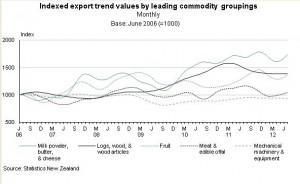Frozen New Zealand beef led an increase in export value for meat and edible offal in July 2012, compared with July 2011, according to Statistics New Zealand (SNZ).
The latest figures show export value for meat and edible offal grew by $25 million (6.9 percent) during the period led by frozen beef, which increased by $22 million. Exports of beef to the US increased by $19 million, leading a $35 million (11 percent) growth in overall exports to that market. This corresponded to a $19 million fall in the value of beef exports to Indonesia.
 Meat and edible offal is still trending upwards in value since its recent low point of February 2012, but is still 11 percent lower than its record high point in July 2011, according to SNZ.
Meat and edible offal is still trending upwards in value since its recent low point of February 2012, but is still 11 percent lower than its record high point in July 2011, according to SNZ.
Overall, the value of exported goods rose $296 million (eight percent) in July 2012 to $4 billion, compared with July 2011. This was led by a rise in the value of milk powder exports, says SNZ.
Imports rose $383 Million (11 percent) to $4 billion, with all three broad economic categories – capital, intermediate and consumption goods – rising in value.
The trade balance for July 2012 was a small surplus of $15 million (0.4 percent of exports). This compares with a surplus of $103 million (2.8 percent) of exports in July 2011.
Seasonally adjusted exports fell 0.4 percent and imports fell 1.5 percent compared with June 2012. Most major export commodities fell, offset by milk powder, butter and cheese, which rose 20 percent, reports SNZ.



